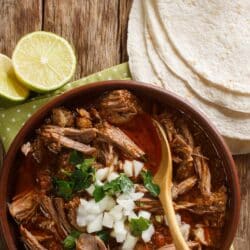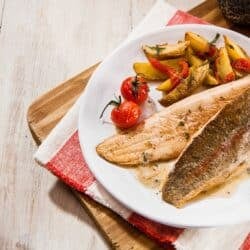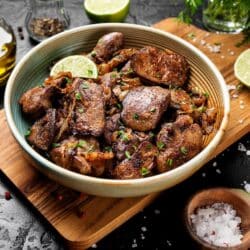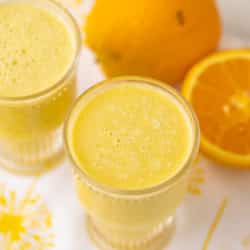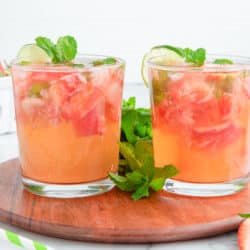Is Birria Healthy (Nutrition Pros and Cons)?
In this blog post, I’ll review the question of whether the dish birria is healthy or not? Find out what the nutrition pros and cons of this Mexican cuisine dish are, plus some better options to consider. For most people, consuming birria is healthy.
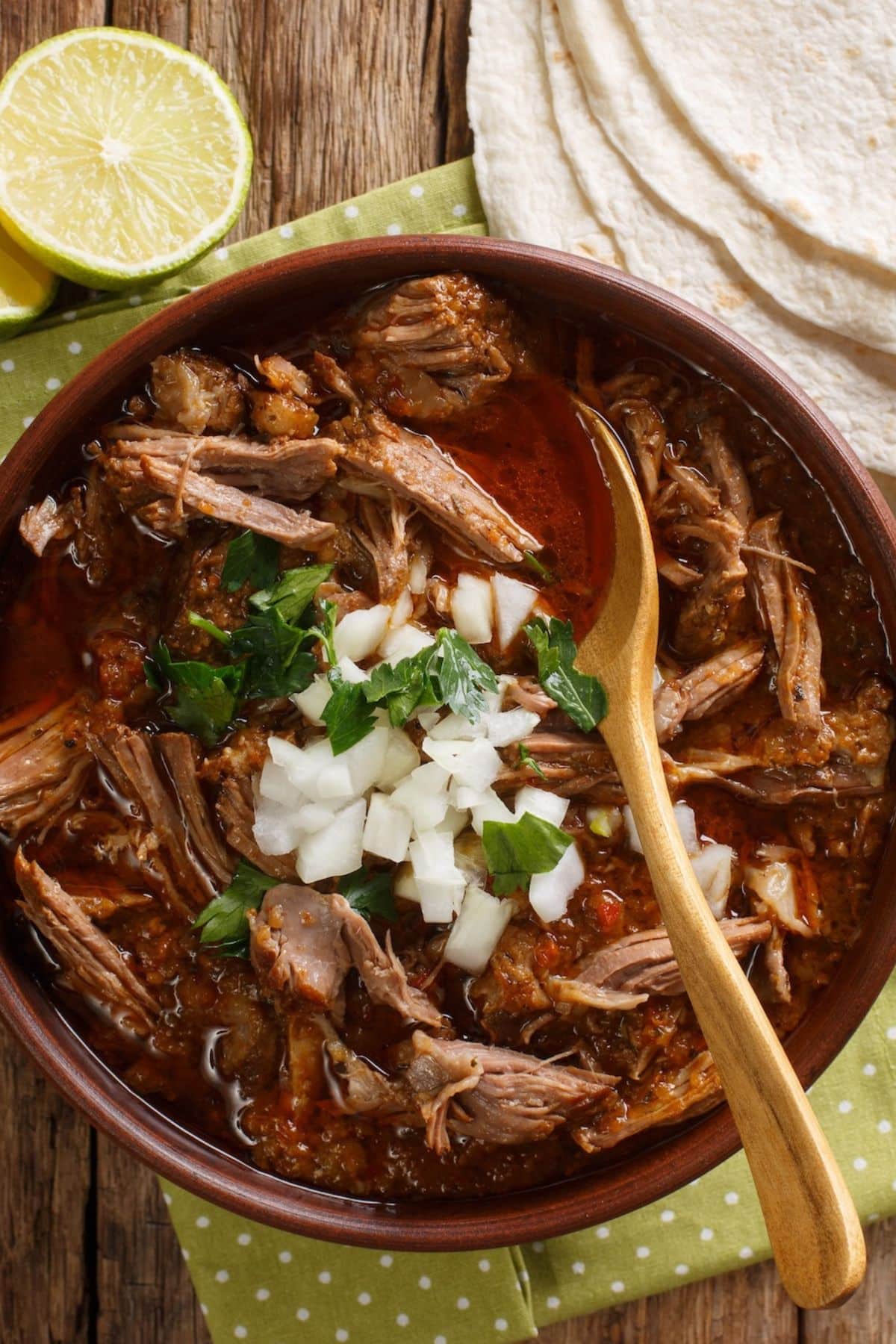
Birria Facts
Spicy, savory, and delicious, birria is a traditional Mexican dish made with slow-cooked meat in a flavorful broth. It was historically made from goat but is now also made from beef, mutton, lamb, or even chicken.
The meat is marinated and then slow-cooked until fall-apart tender in a rich, smoky adobo sauce containing vinegar, spices, herbs, garlic, and dried chili peppers.
Popular throughout the United States and in other countries across the world, birria originated in Guadalajara – the capital and largest city of the Mexican state of Jalisco.
The dish has a fascinating history that dates back to the 16th century. It was created by the indigenous peoples of Mexico during the period of the Aztec Empire’s conquest.
They found themselves with an abundance of goats, given to them by the Spanish Conquistadors who disliked the smell and texture of goat meat. The marination methods used by the natives, however, transformed the meat into something wonderful, and birria was born.
Sadly, it seems the Conquistadors weren’t impressed – the word “birria” in the Spanish slang at that time meant “worthless”, showing the little regard they had for this tasty dish!
These days, birria is often served at Mexican special occasions and during holidays like Christmas and Easter. You can also find it at food trucks, Mexican restaurants, or you can make it at home.
It’s typically presented in a bowl with a topping of fresh cilantro, chopped white onion, and lime juice, along with corn tortillas to mop up the delicious broth.
You’ll even find some interesting variations around – particularly on the street food scene – including birria-filled tacos or flour tortillas with melted cheese, sour cream, known as Quesabirria tacos.
Birria Nutrition Highlights
Birria doesn’t just taste great – it provides a wide range of nutrients, too. Namely, it’s a good source of protein.
Let’s take a closer look at the nutritional content of birria tacos and the overall healthfulness of this popular Mexican dish.
Protein
Since it is a primarily meat-based dish, birria is a rich source of protein.
What’s more, animal proteins are complete proteins, which means they contain all nine essential amino acids that your body is unable to make and needs to obtain from food.
Iron
Consuming birria gives you lots of iron, particularly when it’s made with red meat like beef or goat.
Animal products supply us with heme-iron, a type that our bodies absorb more readily than the non-heme iron found in plant sources.
Vitamins and Minerals
Birria contains a variety of vitamins and minerals from ingredients like garlic, spices, herbs, and chilies used to create the spicy broth in which the stewed meat is cooked.
Thanks to its high meat content it’s a great source of zinc and – if you make it with chicken – it’s high in potassium, too.
What’s more, birria is rich in B vitamins, including B12, riboflavin, and niacin.
Fats
The lovely rich taste and texture of birria come from the fats in the meat it contains.
The actual fat content, however, varies according to the type of meat used and the cut, since some are much fattier than others. You can use leaner meats to make your own birria tacos recipe and use grass-fed beef to keep it part of a healthy diet.
Collagen and Gelatin
Another great thing about birria is its high collagen and gelatin content, especially when the bones are included.
This is because the meat is slow-cooked until tender, releasing collagen into the cooking liquid. The collagen then melts into a protein-rich gelatin, which adds taste, texture, and even more nutrients to the dish.
Nutrition Pros
Birria is high in protein, so it is very satisfying and keeps you feeling full for longer. This makes it a good meal to have if you often find yourself reaching for unhealthy snacks between meals.
It’s also a keto-friendly option, as it’s high in fat, low in carbs, and contains no other non-keto ingredients.
Let’s explore the other health benefits that the nutrients in birria provide.
Better Muscle Health
Birria’s high protein content, along with its beneficial fats, makes it very helpful in building, repairing, and maintaining your muscles.
The fats in birria are not just a source of energy but also help your body absorb the vitamins that are crucial for muscle repair. This is especially good to know if you regularly enjoy physical activity.
Increased Energy Levels
The heme iron in birria helps with the production of hemoglobin in the red blood cells.
Hemoglobin transports oxygen from your lungs around to the rest of your body, helping maintain your energy levels and reducing the risk of iron-deficiency anemia.
The B vitamins in birria may give your energy levels a welcome boost, too, while the fats it contains provide a dense source of energy. These help sustain your body’s energy needs over longer periods.
Strong Immune System
The combination of minerals like iron and zinc from the meat – plus the antioxidants found in the herbs, spices, and other ingredients – make birria a fantastic dish for immune system support.
These nutrients also help wounds heal more quickly and protect your body’s cells from oxidative stress (an imbalance between free radicals and antioxidants). This reduces the risk of serious disease.
Fats help, too, and ensure your immune cells function properly by supporting the cell membranes.
Healthy Skin, Hair, and Joints
The collagen and gelatin produced from the slow cooking of birria meat are good for your joints and also help maintain the elasticity of your skin and connective tissues.
The B vitamins from the meat benefit your hair, nails, and skin, while the fats help your body absorb fat-soluble vitamins.
Nutrition Cons
Although it has many health benefits, there are a couple of downsides to consuming traditionally prepared birria.
The most significant is its high fat content, which gives it the richness for which the dish is famous. It contains both saturated and unsaturated fats, the former of which is linked to heart disease and high cholesterol.
Although the exact amount varies according to the type of meat and cut you use, it’s best to consume birria in moderation and monitor portion sizes to avoid consuming excessive saturated fat and calories.
Another consideration is its sodium content, which can sometimes be pretty high depending on the preparation method used.
If you are monitoring your sodium intake – or suffer from hypertension – it’s best to moderate your consumption of traditionally prepared birria (or make it yourself at home without adding too much salt).
Birria Nutrition FAQs
Traditional birria can contain anywhere from 300 to 500 calories or more per 1 to 1.5 cup serving of birria, and at least 15-25 grams of fat. But, the calorie and fat content can vary enormously depending on the amount, cut, and type of meat it contains, plus the type of oils used during the cooking process.
Generally speaking, chicken is the best low-fat option. This is followed by goat – considered to be the leanest red meat – then beef. Lamb meat tends to have the highest fat content, with even the leanest cuts more marbled with fat than similar cuts of goat or beef.
First, try swapping the red meat in the recipe for chicken, which is leaner and lower in calories. Alternatively, add a unique twist by using vegetarian or vegan ingredients.
If you opt to use meat, stick to lean cuts. You can reduce the overall fat content further by allowing the birria to cool once it’s cooked, then skimming off the fat once it has risen to the surface. Try using the slow cooker to make this process really easy.
Keep the sodium content low by adding a little less salt than the recipe recommends, and using a low-sodium version if available.
Finally, swap carb-rich, high-calorie sides like tortillas, refried beans, and rice for fresh toppings like salads or veggies. This will keep the calorie count down and provide a more balanced meal.
More Food Reviews You Might Like
Conclusions
As you can see, birria is a healthy food for most people and offers lots of benefits. It’s a rich source of nutrients that helps keep your muscles healthy, boosts your immune system, and sustains your body’s energy needs.
That said, traditionally prepared birria is high in fats and sodium, so it’s best to consume it in moderation if you need to limit your fat, calorie, or sodium intake. Better still, try my suggested adaptations to create an even healthier dish with all of the flavor.
Don’t forget to join my newsletter list to get exclusive clean eating recipes and tips. The newsletter is 100% free with no spam; unsubscribe anytime.
About the Author: Carrie Forrest has a master’s degree in public health with a specialty in nutrition and is a certified holistic nutritionist. She is a top wellness and food blogger with over 5 million annual visitors to her site. Carrie has an incredible story of recovery from chronic illness and is passionate about helping other women transform their health. Send her a message through her contact form.
Note: this post is for informational purposes only and is not intended as medical advice. Please consult your healthcare provider for recommendations related to your individual situation.


